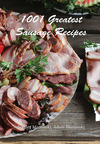Meats and Sausages
Air Dried Meats and Sausages
Preserving thinly sliced meat by drying was practiced in many areas of the world and the technology was basically the same. Even Eskimos who lived in the coldest climate on earth were preserving seal or whale meat by drying it in the open air. The best known air dried meats are:
- Hams
- Pork butts
- Jerky
- Pemmican
- Biltong
- Sausages
We all know that meat would spoil if not kept under refrigeration so the concept of drying meat seems to be very difficult and dangerous. And it is, unless proper steps are taken. This is not rocket science and we could do it thousands of years ago when computers were not around and the word meat science was not invented yet, we should be able to produce air dried meats without a sweat today. It is necessary to know the basics well, the good news is that the basics like many other things depend to a great extent on common sense and logic. Air dried, fermented and cold smoked meats are intimately related and follow the same guidelines. A reader is referred to the Chapter on Fermented Meats which includes a lot of information on drying and safety.
Take for example traditionally made Hungarian salami. The sausage is made without sugar so we may say that there is no fermentation. The small account of glycogen (sugar) that meat contains and any resulting fermentation can be considered negligible. The whole process of making this sausage depends on drying. The Spanish will call it chorizo and in Lithuania they will cold smoke sausages and after drying it will be called Cold Smoked Sausage. Of course it is more complicated to dry a huge piece of meat such as a ham than a thinly cut strip of meat that will become jerky, nevertheless the rules of the game remain basically the same. You can not just hang meat and let it dry as it will spoil. Even when left in a refrigerator it will spoil although at a slower rate. You have to prevent bacteria from growing and that is accomplished by:
- Applying salt. This prevents bacteria from growing and removes moisture. The less moisture remains, the harder it is for bacteria to grow.
- Adding nitrite/Nitrate. This prevents pathogenic bacteria, notably Clostridium botulinum from growing.
- At the beginning of the process keeping meat at refrigerator temperature. This prevents bacteria from growing.
- Drying in the air. Once the meat has lost some moisture it is safer to continue drying in the air at 50-54° F (10-12° C). We don't want to dry meat in the "danger zone" 60-140° F (16-60° C) when bacteria find favorable conditions to grow. When drying is accomplished in a dehydrator (jerky) the temperature should be 145° F (63° C) which is above the danger zone.
This leads to a common question "what if I don't want to use nitrates"? A commercial producer must conform to the Government standards and he has to use them. It is possible to obtain permission from the Food Inspection and Safety service to make products without nitrite, but this is a very costly and involved process. Needless to say such an establishment will be under great scrutiny of meat inspectors and most processors don't want to be bothered with such a waiver.
It is not expected that an Eskimo will cure seal or whale meat with nitrites. They would rather pound their meat pieces until thin, and dry them in windy and cold conditions that most of us will find impossible to duplicate. It also goes without saying that it takes longer to remove moisture from the inside of a 18 lb. ham than a 2 oz. strip of meat. More Nitrate can be safely applied to a meat that will dry for a year as the Nitrates dissipate slowly in time. For this reason you can apply 625 ppm of sodium nitrite to a dry product and only 156 ppm to a regular smoked sausage. The salt is applied at around 6% to a country ham which needs plenty of protection, about 3% for a dry fermented sausage, 2.5% for semi-dry fermented sausage and only 1.8% for a smoked one. At home you can do whatever pleases you, although we don't see why someone would not want to make products in a safe way.
















